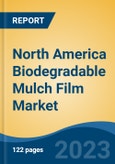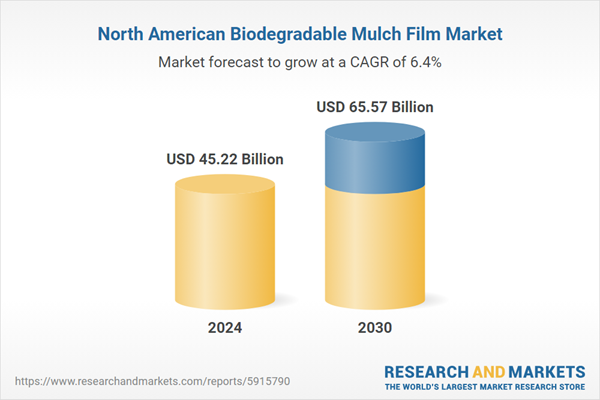Free Webex Call
The North America Biodegradable Mulch Film Market was valued at USD 45.22 Billion in 2024, and is expected to reach USD 65.57 Billion by 2030, rising at a CAGR of 6.39%. The North America Biodegradable Mulch Film Market is experiencing significant growth and transformation in recent years as sustainability and environmental concerns gain prominence in agriculture practices across the region. Biodegradable mulch films, also known as biofilms, are an eco-friendly alternative to traditional plastic mulch films commonly used in farming. This market segment within North America is characterized by a surge in demand for biodegradable materials that can replace conventional plastics while promoting soil health and reducing environmental impact. Speak directly to the analyst to clarify any post sales queries you may have.
10% Free customizationThis report comes with 10% free customization, enabling you to add data that meets your specific business needs.
One of the primary drivers behind the growth of the North America Biodegradable Mulch Film Market is the increasing awareness among farmers and agricultural stakeholders about the detrimental effects of plastic mulch films on the environment. Biodegradable mulch films are made from organic materials such as starch, cellulose, and polylactic acid (PLA), which break down naturally in the soil, eliminating the need for labor-intensive removal and disposal. This not only reduces plastic waste but also enhances soil quality, fostering healthier crop growth.
Key Market Drivers
Environmental Awareness and Sustainability
Environmental awareness and sustainability have emerged as powerful drivers behind the rapid growth of the North America Biodegradable Mulch Film Market. In recent years, a heightened consciousness of environmental issues, coupled with a growing commitment to sustainable practices, has propelled the adoption of biodegradable mulch films in the agricultural sector. Farmers and agricultural stakeholders are increasingly recognizing the ecological implications of traditional plastic mulch films, which persist in the environment for extended periods, contributing to plastic pollution.Biodegradable mulch films, made from organic materials like starch, cellulose, and polylactic acid (PLA), break down naturally in the soil, eliminating the need for labor-intensive removal and disposal. This aligns with the principles of sustainability, as it not only reduces plastic waste but also promotes soil health and reduces the environmental footprint of agriculture.
Farmers and growers across North America are responding to this environmental awareness by transitioning to biodegradable mulch films as a more ecologically responsible choice. Biodegradable mulching films have significantly improved in usability, enabling cultivators to plow them into the soil after use rather than collecting them for recycling, thereby enhancing operational efficiency. However, the potential environmental impacts of biodegradable mulches remain insufficiently studied. International standards, including ISO 17088, ASTM D6400, ISO 17556, and ASTM D5988, are still under ongoing research to validate their safety and effectiveness.
Key Market Challenges
Cost Considerations
The primary cost-related challenge is the higher initial investment required for biodegradable mulch films. These films are typically made from organic materials such as starch, cellulose, and polylactic acid (PLA), which can be more expensive than the petroleum-based plastics used in traditional mulch films. For many growers, especially smaller and financially constrained operations, the upfront cost of switching to biodegradable mulch films can be a significant barrier.The cost considerations extend beyond the purchase price of biodegradable mulch films. Growers must also evaluate the economic viability of using these films over the long term. While biodegradable films offer environmental benefits, their higher cost can affect the overall profitability of farming operations. This calculation often includes factors such as yield improvement, reduced labor costs (due to less weeding), and potential premium pricing for eco-friendly produce. For some growers, the return on investment may not be immediately apparent or favorable, making it challenging to justify the switch.
Key Market Trends
Government Regulations and Bans
Government regulations and bans are playing a pivotal role in boosting the North America Biodegradable Mulch Film Market. In recent years, there has been a growing recognition of the environmental impact of single-use plastics in agriculture, particularly in the context of plastic mulch films. Many states and provinces within North America have responded by implementing stringent regulations and even bans on the use of conventional plastic mulch films, citing concerns over plastic waste and pollution.These regulatory measures have created a favorable environment for the adoption of biodegradable mulch films. Biodegradable mulch films, composed of organic materials that break down naturally in the soil, align perfectly with the objectives of reducing plastic waste and promoting sustainable farming practices. Growers, faced with the need to comply with these regulations, have increasingly turned to biodegradable mulch films as a viable alternative. Additionally, the bans on plastic mulch films serve as a clear signal to the agricultural industry that environmentally friendly practices are not only encouraged but mandated. This regulatory pressure has encouraged growers to explore sustainable alternatives and has accelerated the transition to biodegradable mulch films.
Key Market Players
- BASF SE
- Kingfa Sci & Tech Co Ltd
- BioBag International AS
- AEP Industries Inc.
- RKW SE
- British Polythene Industries PLC
- Armando Alvarez
- Al-Pack Enterprises Ltd.
- Novamont
- AB Rani Plast OY.
Report Scope:
In this report, the North America Biodegradable Mulch Film Market has been segmented into the following categories, in addition to the industry trends which have also been detailed below:North America Biodegradable Mulch Film Market, By Raw Material:
- Thermoplastic Starch (TPS)
- Starch Blended with Polylactic Acid (PLA)
- Starch Blended with Polyhydroxyalkanoate (PHA)
- Aliphatic Aromatic Copolyesters (AAC)
- Others
North America Biodegradable Mulch Film Market, By Crop:
- Fruits & Vegetables
- Grains & Oilseeds
- Flowers & Plants
North America Biodegradable Mulch Film Market, By Country:
- United States
- Canada
- Mexico
Competitive Landscape
Company Profiles: Detailed analysis of the major companies present in the North America Biodegradable Mulch Film Market.Available Customizations:
With the given market data, the publisher offers customizations according to a company's specific needs. The following customization options are available for the report.Company Information
- Detailed analysis and profiling of additional market players (up to five).
This product will be delivered within 1-3 business days.
Table of Contents
1. Product Overview
2. Research Methodology
3. Executive Summary
4. North America Biodegradable Mulch Film Market Outlook
5. United States Biodegradable Mulch Film Market Outlook
6. Canada Biodegradable Mulch Film Market Outlook
7. Mexico Biodegradable Mulch Film Market Outlook
8. Market Dynamics
9. Market Trends & Developments
11. Porter’s Five Forces Analysis
12. Competitive Landscape
Companies Mentioned
- BASF SE
- Kingfa Sci & Tech Co Ltd
- BioBag International AS
- AEP Industries Inc.
- RKW SE
- British Polythene Industries PLC
- Armando Alvarez
- Al-Pack Enterprises Ltd.
- Novamont
- AB Rani Plast OY.
Table Information
| Report Attribute | Details |
|---|---|
| No. of Pages | 120 |
| Published | March 2025 |
| Forecast Period | 2024 - 2030 |
| Estimated Market Value ( USD | $ 45.22 Billion |
| Forecasted Market Value ( USD | $ 65.57 Billion |
| Compound Annual Growth Rate | 6.3% |
| Regions Covered | North America |
| No. of Companies Mentioned | 10 |









